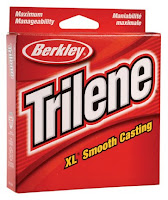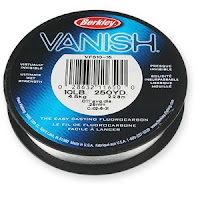You may have encountered the massive wall of fishing line you’ll find at most fishing tackle retailers these days. It seems there are almost too many choices with more offered all the time. Much emphasis is placed on rods and reels and baits, but often fishing line is overlooked. Line selection can make the difference between an average day of fishing and a tremendous day of fishing and is the only link between you and that catch of a lifetime.
There are three main types of line: monofilament, braided, & fluorocarbon. Monofilament is the easiest to work with. This type of line makes knot tying simple and casts well especially when new. It has the ability to stretch, which is a pro and a con for mono. It can help absorb the force of a fighting fish, but reduces sensitivity making some light bites difficult to detect. The stretch also saves the bait frequently when snagged. Reversing the boat back over the snag usually will free the bait. Mono is subject to abrasion and has spool memory so it needs replaced if it remains on the reel for extended periods of time. My favorite monofilament line to use is Berkley Trilene XL.
Braided line is newer to the angling community, but does have some distinct advantages. Braided line has minimal stretch which means you feel lighter hits and often hook a greater number of fish. It is also easier to distinguish between bumping a rock, log, or an actual bite. Knots are tougher to tie with this line and so is cutting it. Read the directions on the box for recommended knots or go with the Palomar knot. You can learn this knot here: http://www.activeangler.com/articles/how-to/articles/knots/palomar.asp. When using braided line you also need to either use a lighter action rod or reduce your drag to prevent pulling the hook out of a fish’s mouth. Berkeley Fireline is a very recognizable braided line. I also like PowerPro especially when it comes to casting.
Fluorocarbon is the newest innovation in fishing line. It comes the closest to matching the refractive index of water and is virtually invisible when submerged. It is a low stretch line and sinks which helps when fishing crankbaits deep. It is abrasion resistant, but does have spool memory. Be sure to wet knots before tightening when working with flurocarbon since it is very susceptible to heat damage. The most popular fluorocarbon is Berkeley Vanish.
So, which one should you use? It’s a matter of preference. My favorite selections vary depending on the type of fishing I’m doing. My favorite all-purpose line is monofilament. This line is simple to use and can be successfully used for jigging, casting, & trolling. If you have a couple reels to bring and can specialize your choices then I prefer braided line and fluorocarbon together when jigging. Braided lines are much more visible to fish so I prefer to use braided line tipped with a fluorocarbon leader. This provides the best of both worlds – super sensitivity and invisibility. When spending a day casting I opt for braided line like PowerPro. If trolling is on the agenda, I select a fluorocarbon. Try the different types and see which one you prefer. Let us know which line or combinations you have had success with fishing in Red Lake!


